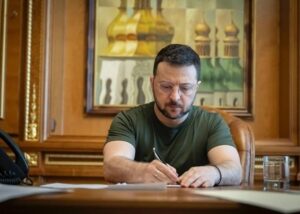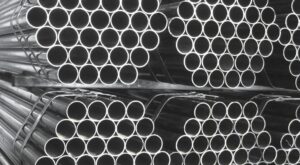
The President has signed Decree No. 528/2025, appointing Sergiy Pogoreltsev Ambassador Extraordinary and Plenipotentiary of Ukraine to Mexico (including accreditation in Panama, Belize, Guatemala and Costa Rica).
Pogoreltsev is a career diplomat who has represented Ukraine in Spain, Andorra and the World Tourism Organization since 2020. Diplomatic relations between Ukraine and Mexico were established in 1992.

In the first six months of 2025, NovaPay customers made 205 million transfers, which is 6% more than in the first six months of 2024.
“The total volume of transactions through the system reached UAH 172 billion, which is 26% more than last year,” the company said in a press release on Tuesday.
According to NovaPay CEO Andriy Kryvoshapko, the company’s total direct investment in the first half of 2025 amounted to UAH 230 million, and the volume of taxes for this period increased by 12% compared to the first half of 2024 – up to UAH 765 million.
NovaPay is an international financial service that is part of the NOVA group of companies (Nova Poshta). The company, which employs 13,000 people, serves customers both online and in more than 3,600 Nova Poshta branches.
According to the NBU, its share in the remittance market was 22.7%.
The company was the first non-bank institution in Ukraine to receive an extended license from the NBU, which allows it to open accounts and issue payment cards.

President of Ukraine Volodymyr Zelenskyy has signed Decree No. 524/2025 appointing Yuriy Lutovinov Ambassador Extraordinary and Plenipotentiary of Ukraine to Japan.
Mr. Lutovinov is a career diplomat who has headed the Department for Euro-Atlantic Integration in the Office of the President since 2023 and previously served as Minister Counselor at the Ukrainian Embassy in Tokyo from 2015-2021. He is fluent in Japanese and has a deep understanding of the country, a skill that Zelenskyy considers important for strengthening Ukraine-Japan relations.
Ukraine opened an embassy in Japan in 1995 (officially opened on March 23), and diplomatic ties were established in 1992.

PJSC Centravis Production Ukraine (Nikopol, Dnipro region), a part of Centravis Ltd. holding, presented two projects to modernize production and expand pipe production for a total of $14.5 million at the Ukraine Recovery Conference (URC2025) held on July 10-12 in Rome.
According to the company’s information in the URC project catalog, the first project concerns the segment of oil and gas tubular goods (OCTG). It involves the development and supply of seamless pipes and stainless steel pipes that meet 25 CRA (corrosion-resistant alloy) standards, with a focus primarily on the fast-growing market for carbon capture and storage (CCS) infrastructure in the United States and Europe.
It is expected that new equipment will be purchased to produce pipes, couplings and casing for CO2 or oil wells in accordance with the API 5 CRA standard. Diameter – from 60 mm to 240 mm, length 11-13 m, wall thickness – in a wide range.
Target market: carbon capture applications in the US and Europe, oil and gas in the US, Europe, and the Middle East.
The scope of work for the project has already been determined, the preliminary tender process for its budget has been completed, and the project is ready for implementation. The equipment is planned to be installed at Centravis’ premises in Nikopol in the hot shop. API 5 CRA licensing is expected by the end of 2025.
The total project budget is $11 million, and $10 million needs to be raised, according to the company. Expected financial indicators: net present value (NPV) – $13.3 million, revenue in 2030 – $45 million, EBITDA in 2030 – $18 million.
The project launch period is two years.
Until 2025, $0.1 million will be invested in the development of the concept and technical design, this year $0.3 million will be needed for design, in 2026 – $4.6 million for construction, in 2027 – $6 million for the start of operation.
The second project is to expand the product range by launching the production of small-sized (4 mm in diameter) seamless stainless pipes with high precision. The project will allow the company to enter the hydrogen, semiconductor, medical, and aerospace industries. It is expected to expand Centravis’ product offering, strengthening its position in the precision tubing market, as this is a highly profitable segment. The target market is America, Europe, Asia, and the Middle East.
The technological parameters of the project include the purchase of equipment to support production.
This project is also ready to be implemented: the scope of work has been determined, and the preliminary tender process for its budget has been completed. The equipment is planned to be installed at the Centravis premises in Uzhhorod. At the same time, it is specified that this project will be developed mainly on its own.
Its total budget is $3.5 million, and $3 million is needed to raise it. Expected financial indicators: net present value (NPV) – $5.5 million, revenue in 2030 – $7.5 million, EBITDA in 2030 – $2.5 million.
The project launch period is two years.
At the same time, $0.2 million should be invested in the project in 2025 for design and construction, and in 2026, funding of $3.3 million will be required to start operations.
As reported, Centravis increased its production of seamless stainless pipes by 12.6% in 2024 compared to 2023, to 13.7 thousand tons. Centravis exported almost all of its products.
The company plans to increase production to 15 thousand tons in 2025.
“Founded in 2000, Centravis is one of the ten largest producers of seamless stainless steel pipes in the world. Its main production facilities are located in Nikopol (Dnipropetrovska oblast). In 2023, the company opened a branch in Uzhhorod.
Centravis Holding Ltd. was established on the basis of Nikopol Stainless Pipe Plant CJSC, service and trading companies of Production and Commercial Enterprise YUVIS LLC. Its shareholders are members of the Atanasov family. Centravis Ltd. owns 100% of the shares in Centravis Production Ukraine.

Current trends and drivers of cryptocurrency growth
Institutional involvement and legislation
ETFs and ICO activity
Real-world asset (RWA) tokenization
Technologies and AI tokens
Security and hacker attacks
Forecast for the end of July and August
Bitcoin (BTC)
Ethereum (ETH)
Growth and pressure factors
Growth.
Risks:
Source: https://www.fixygen.ua/news/20250722/oglyad-kriptovalyut-na-22-chervnya-2025-roku-vid-fixygen.html